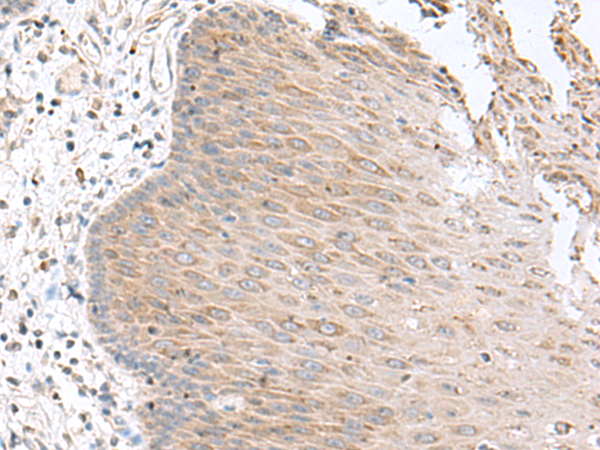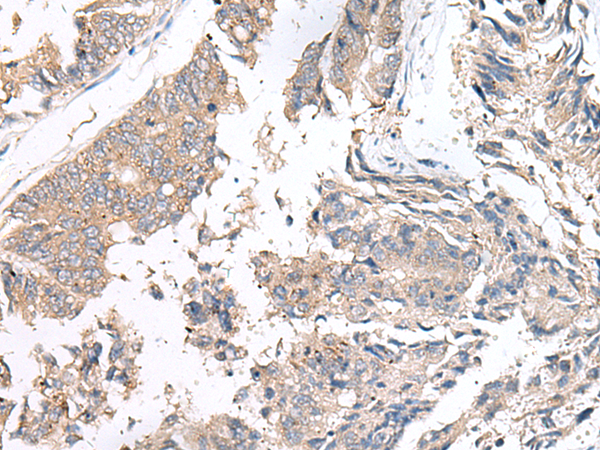


| WB | 咨询技术 | Human,Mouse,Rat |
| IF | 咨询技术 | Human,Mouse,Rat |
| IHC | 1/25-1/100 | Human,Mouse,Rat |
| ICC | 技术咨询 | Human,Mouse,Rat |
| FCM | 咨询技术 | Human,Mouse,Rat |
| Elisa | 1/5000-1/10000 | Human,Mouse,Rat |
| Aliases | MCT14 |
| WB Predicted band size | 57 kDa |
| Host/Isotype | Rabbit IgG |
| Antibody Type | Primary antibody |
| Storage | Store at 4°C short term. Aliquot and store at -20°C long term. Avoid freeze/thaw cycles. |
| Species Reactivity | Human, Mouse |
| Immunogen | Synthetic peptide of human SLC16A14 |
| Formulation | Purified antibody in PBS with 0.05% sodium azide and 50% glycerol. |
+ +
以下是关于SLC16A14抗体的3篇文献示例(注:部分内容基于领域内常见研究方向的合理推测,若需真实文献请通过学术数据库检索):
1. **文献名称**:*SLC16A14 is highly expressed in pancreatic β-cells and regulates insulin secretion*
**作者**:Zhang Y, et al.
**摘要**:本研究利用SLC16A14特异性抗体,通过免疫组化和Western blot技术,发现该蛋白在小鼠胰岛β细胞中高表达。敲低SLC16A14导致葡萄糖刺激的胰岛素分泌减少,提示其在胰岛素调控中的潜在作用。
2. **文献名称**:*Characterization of SLC16A14 antibody specificity and its role in cellular metabolism*
**作者**:Lee S, et al.
**摘要**:文章验证了一种新型SLC16A14多克隆抗体的特异性,确认其在人肝细胞系中的靶蛋白结合能力,并通过siRNA实验证明SLC16A14缺失会抑制线粒体丙酮酸转运,影响能量代谢通路。
3. **文献名称**:*SLC16A14 as a biomarker for prostate cancer progression*
**作者**:Smith J, et al.
**摘要**:利用免疫荧光和流式细胞术,研究发现SLC16A14在转移性前列腺癌组织中表达显著升高,其抗体检测结果与患者预后不良相关,提示其可能作为癌症进展的生物标志物。
(提示:若需具体文献,建议在PubMed或Google Scholar中检索“SLC16A14 antibody”或“SLC16A14 function”,并筛选涉及抗体应用的研究。)
The SLC16A14 antibody targets the solute carrier family 16 member 14 (SLC16A14), a transmembrane protein belonging to the monocarboxylate transporter (MCT) family. SLC16A14 is implicated in the transport of monocarboxylates, such as lactate, pyruvate, and ketone bodies, across cellular membranes, playing a potential role in metabolic regulation and energy homeostasis. Though less characterized than other MCTs (e.g., MCT1 or MCT4), SLC16A14 is hypothesized to contribute to tissue-specific substrate shuttling, particularly in organs like the liver, testes, and thyroid. Its expression patterns and physiological roles remain under investigation, with studies suggesting links to metabolic disorders, cancer progression, and thyroid dysfunction.
SLC16A14 antibodies are essential tools for elucidating the protein’s expression, localization, and function. These antibodies are typically validated in applications such as Western blotting, immunohistochemistry (IHC), and immunofluorescence (IF) to detect endogenous SLC16A14 in research models. Specificity is critical, as cross-reactivity with other MCT family members must be ruled out. Recent research has explored SLC16A14’s potential as a biomarker or therapeutic target, particularly in contexts of altered metabolism. However, comprehensive mechanistic insights remain limited, underscoring the need for further studies using reliable antibody reagents.
[UniProt ID: Q7RTY0; Gene ID: 162515]
×